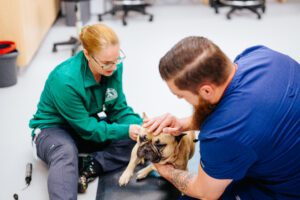When your dog suddenly seems disoriented, struggles to walk, or tilts its head, it’s natural to be concerned. These symptoms may indicate vestibular disease, a condition that affects the balance and coordination system in your dog’s inner ear and brain. Recognizing the signs of this disease early and seeking the proper care can help your dog recover more effectively.

What is Vestibular Disease in Dogs?
Vestibular disease in dogs is a condition that disrupts the normal functioning of the vestibular system, which is responsible for maintaining balance and spatial orientation. The vestibular system includes parts of the inner ear and brain that help control your dog’s ability to walk straight, keep its head level, and move its eyes normally. When this system is compromised, your dog may exhibit a range of symptoms, including loss of balance, head tilting, and involuntary eye movements.
Peripheral vs. Central Vestibular Disease
Vestibular disease can be classified into two main types: peripheral and central. Peripheral vestibular disease is the most common form and affects the inner ear. It often arises suddenly and can be very alarming, but it typically has a better prognosis. Central vestibular disease, on the other hand, affects the brainstem and can be more serious, requiring prompt veterinary attention.
Causes of Vestibular Disease in Dogs
The causes of vestibular disease in dogs can vary, depending on whether the condition is peripheral or central. Peripheral vestibular disease is often idiopathic, meaning its cause is unknown. However, it can also be triggered by ear infections, head trauma, or certain medications that affect the inner ear.
Central vestibular disease may be caused by a variety of issues, including brain tumors, infections, or inflammation in the brain, or even a stroke. Because central vestibular disease involves the brain, it is generally considered more severe than peripheral vestibular disease and requires immediate medical evaluation.
Possible Symptoms of Vestibular Disease
Identifying the symptoms of vestibular disease in dogs early on can help you seek veterinary care promptly. The most noticeable signs include:
- A head tilt, which may be slight or severe
- Loss of balance, causing your dog to stagger or fall
- Rapid, involuntary eye movements, known as nystagmus
- Disorientation or confusion
- Nausea or vomiting
- Reluctance to eat or drink
Diagnosing Vestibular Disease in Dogs
Here is what to expect when you bring your dog to Compass Veterinary Neurology & Imaging for symptoms of vestibular disease:
- Physical Examination: The first step will be a thorough physical examination. Your veterinarian will assess your dog’s balance, eye movements, and reflexes to determine the severity and type of vestibular disease.
- Diagnostic Testing: To rule out other potential causes of the symptoms, your vet may recommend diagnostic tests such as blood work, ear exams, or advanced imaging techniques like an MRI or CT scan. These tests help identify whether the disease is peripheral or central and guide the appropriate course of treatment. At Compass Veterinary Neurology & Imaging, our state-of-the-art diagnostic tools allow us to accurately diagnose and treat vestibular disease in dogs.
Treatment Options for Vestibular Disease in Dogs
Treatment for vestibular disease in dogs depends on the underlying cause and whether the condition is peripheral or central.
Caring for Peripheral Vestibular Disease
In many cases of idiopathic peripheral vestibular disease, the symptoms may resolve on their own with supportive care. Your veterinarian may prescribe medications to help manage symptoms such as nausea or to address any underlying ear infections that may have triggered the condition.
Addressing Central Vestibular Disease
For central vestibular disease, the treatment plan will be more complex and may involve addressing the specific cause, such as treating an infection, reducing inflammation, or managing a brain tumor. In some cases, your dog may require hospitalization to receive intensive care, especially if the symptoms are severe.
Home Care and Recovery
While your dog is recovering from vestibular disease, providing a safe and comfortable environment at home can be helpful. Offering soft bedding, keeping food and water within easy reach, and avoiding stairs or slippery surfaces that could cause falls can also aid in your pet’s recovery. With time and proper care, many dogs with peripheral vestibular disease can make a full recovery, although some may retain a slight head tilt.
Helping Your Dog Regain Confidence
After experiencing vestibular disease, your dog may be hesitant to return to normal activities, especially if the symptoms were severe. Gradual reintroduction to regular exercise, combined with positive reinforcement, can help your dog regain confidence. Start with short, supervised walks and slowly increase the duration as your dog’s balance improves.
How Physical Therapy Can Help
In some cases, your veterinarian may recommend physical therapy to help strengthen your dog’s muscles and improve coordination. At Compass Veterinary Neurology & Imaging, we work closely with pet owners to develop tailored rehabilitation plans that support your dog’s recovery.
When Is Further Veterinary Care Necessary?
Although many dogs recover well from vestibular disease, monitor your pet for any signs of lingering issues or complications. If your dog continues to show symptoms such as a persistent head tilt, difficulty walking, or if new symptoms arise, contact your primary veterinarian or the team at Compass Veterinary Neurology & Imaging immediately. These could be signs of an underlying condition that requires further investigation.
At Compass Veterinary Neurology & Imaging, we are committed to helping your dog get back on track. If you notice any concerning symptoms or if your dog’s condition does not improve, please call us at (410) 224-0121 ext. 5 or book an appointment online today. Our experienced team is here to provide the compassionate and specialized care your dog needs to recover fully.
